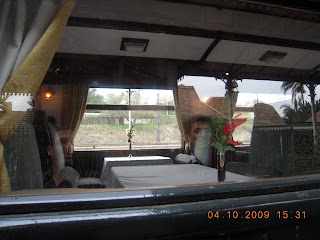Pietermaritzburg is a small town, 67 kilometres north-west of Durban. It is a name we hear for the first time when we reach Durban. The town’s claim to a place on the tourist map? Its railway station.
When we hit the town, we drive straight to the station. The railway building itself is a small, red brick building with a shingled sloping roof, iron pillars in the front and rectangle windows that give it a gingerbread house look.
A clock hangs on the porch outside, its needles stuck somewhere in time. Maybe it indicates the arrival time of the next train in that station. Maybe it was set to a time that has a historic significance to that town. Maybe and this is perhaps the closest to the truth, its just broken.
We cross a Spartan waiting hall and enter the platform. A train waits there. ‘Pride of Africa’ says the board on the train and we learn it is a luxury tourist train from Pretoria to Cape Town along the popular Garden Route. It is very swank train, perhaps South Africa’s answer tour Palace –on-wheels.
A view of the interiors of ‘Pride of Africa’ from the platform
We walk down the platform in the direction our local guide points us. There is a slight nip in the air and I pull my jacket close as I walk. It is an afternoon in early October, almost the beginning of summer.
We stop at a culvert on the platform. We stand around it and read.
June would have been winter in the southern hemisphere and if this was spring, I think, winters must be cold here. I ask and discover that it can go as low as ten degrees Celsius. I look around and can almost see a cold but determined Mohandas Gandhi standing on this platform on a dark chilly night and making a silent promise to himself to change the fate of non-whites. I suppress an irreverent thought that tells me if the Brits had had even an inkling of the trouble he would cause, they might have let him stay on board.
There is a moment of awe as we stand there and absorb the histories of two counties, two continents and the world.
Back in the hall, we two plaques on the wall, commemorating the incident, one commemorating the incident and the other declaring that the first plaque was unveiled by Abdul Kalam. There is also an account of the event, in Gandhiji’s own words, taken from his autobiography.
Through the windows, I see Gandhiji’s photo in the wall of an inner room. This is not Gandhi, the suave lawyer from Durban, but the Khadi- clad Bapu of our history books. I feel cheated. Then did not know why but now as write I know why. The Gandhi I want to see here is the Mohandas to whom the incident happened, not the Bapu who evolved from it.
Our local guide tells us that there a plan in the awning to erect a statue of Gandhi here. But, somehow, the history seems more poignant and meaningful with just the board in the platform and the plaque with Mahatma’s words.
We leave as we came. The clock is still stuck in some other time and only when we leave Pietermaritzburg far behind do we realise that we never found out the secret of the clock.
An edited version of this article appeared in the Sunday Supplement of the DNA-
http://dnasyndication.com/showarticle.aspx?nid=DNMUM166579
http://dnasyndication.com/showarticle.aspx?nid=DNMUM166579



No comments:
Post a Comment